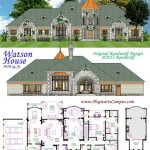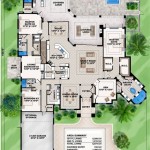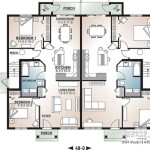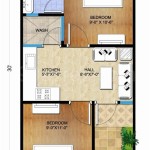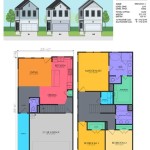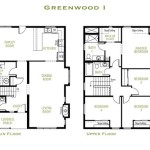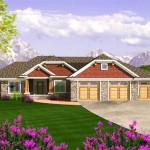Single Story House Plans With High Ceilings: Design, Benefits, and Considerations
Single-story house plans with high ceilings represent a popular architectural choice that combines the convenience and accessibility of ranch-style living with the added spaciousness and aesthetic appeal of elevated ceilings. This design approach offers a unique blend of comfort, visual interest, and functional advantages, making it an attractive option for a wide range of homeowners. Understanding the nuances of this design, from its inherent benefits to the crucial considerations for implementation, is essential for anyone contemplating this style of home.
High ceilings, generally defined as ceilings exceeding the standard eight or nine feet, significantly impact the overall feel of a home. In a single-story layout, where the horizontal plane is emphasized, high ceilings create a sense of vertical expansion, mitigating the potential for a cramped or confined atmosphere. This is particularly beneficial in smaller homes or those with open-concept living spaces, where the increased volume contributes to a more airy and inviting environment.
The design process for single-story houses with high ceilings requires careful planning to ensure structural integrity, energy efficiency, and aesthetic harmony. Architects and designers must consider various factors, including roof design, insulation, lighting, and window placement, to optimize the benefits of high ceilings while minimizing potential drawbacks. This article will explore the key aspects of single-story house plans with high ceilings, providing valuable insights for homeowners, builders, and designers alike.
Enhanced Aesthetics and Natural Light
One of the primary advantages of incorporating high ceilings into a single-story house plan is the significant improvement in aesthetics and the opportunity for increased natural light penetration. Higher ceilings create a sense of grandeur and spaciousness, making rooms feel larger and more open. This can be particularly effective in living rooms, dining areas, and master bedrooms, where creating a relaxed and inviting atmosphere is paramount.
The increased vertical space allows for larger windows and transoms to be incorporated into the design. These larger openings permit more natural light to enter the home, reducing the need for artificial lighting during the day. Natural light has been shown to have numerous health benefits, including improved mood, reduced stress, and increased productivity. Strategically placed windows can also provide better ventilation, contributing to a healthier indoor environment.
Furthermore, high ceilings provide an excellent canvas for decorative elements such as chandeliers, pendant lights, and ceiling fans. These fixtures can add visual interest and style to a room, enhancing its overall aesthetic appeal. Exposed beams, vaulted ceilings, and other architectural details can also be incorporated to further enhance the visual interest and character of the home. The opportunity to personalize the ceiling space allows homeowners to express their individual style and create a unique and inviting living environment.
The use of clerestory windows, positioned high up on the walls, is another effective way to maximize natural light in spaces with high ceilings. These windows allow light to enter the room without compromising privacy, as they are typically located above eye level. Clerestory windows can also contribute to better air circulation, helping to keep the home cool during warmer months.
Improved Air Circulation and Ventilation
In addition to enhancing aesthetics and natural light, high ceilings in single-story homes can significantly improve air circulation and ventilation. Hot air naturally rises, and high ceilings provide ample space for this warm air to accumulate away from the living areas. This can lead to a more comfortable indoor temperature, especially during the summer months. The increased airflow can also help to reduce the buildup of stale air and odors, contributing to a healthier and more pleasant living environment.
Effective ventilation is crucial for maintaining good indoor air quality. High ceilings, combined with strategically placed windows and vents, can help to facilitate natural ventilation, reducing the reliance on air conditioning and other mechanical systems. This can lead to significant energy savings and a reduced carbon footprint. Cross-ventilation, achieved by opening windows on opposite sides of the house, is particularly effective at promoting airflow and removing stale air.
Ceiling fans are another valuable addition to homes with high ceilings. These fans help to circulate air, keeping the room cool in the summer and warm in the winter. During the summer, ceiling fans create a cooling breeze by circulating air across the skin. During the winter, they can be used to push warm air down from the ceiling, helping to distribute heat more evenly throughout the room.
The increased volume of air in rooms with high ceilings also allows for better humidity control. This can be particularly important in areas with high humidity, where excessive moisture can lead to mold and mildew growth. Proper ventilation and air circulation can help to prevent these problems, creating a healthier and more comfortable living environment.
Design Considerations and Potential Challenges
While single-story house plans with high ceilings offer numerous benefits, it is crucial to carefully consider the design aspects and potential challenges associated with this architectural style. One of the primary considerations is the structural integrity of the roof. High ceilings often require more complex roof designs, which can increase construction costs and require specialized engineering expertise. The roof must be able to withstand various weather conditions, including heavy snow loads, strong winds, and extreme temperatures.
Insulation is another critical consideration. With increased ceiling height, there is a greater surface area for heat to escape during the winter and enter during the summer. Proper insulation is essential to maintain energy efficiency and minimize heating and cooling costs. Different types of insulation, such as fiberglass, cellulose, and spray foam, have varying R-values and installation requirements. Choosing the right type of insulation and ensuring proper installation are crucial for maximizing energy savings.
Heating and cooling systems must also be adequately sized to accommodate the increased volume of air in rooms with high ceilings. A system that is too small will struggle to maintain a comfortable temperature, while a system that is too large will be inefficient and costly to operate. Consulting with a qualified HVAC professional is essential to determine the appropriate size and type of system for the home.
Lighting design is also crucial in homes with high ceilings. The increased vertical space requires careful planning to ensure adequate illumination and avoid dark spots. Recessed lighting, pendant lights, and wall sconces can be used to create a well-lit and visually appealing space. The placement and intensity of the lighting fixtures should be carefully considered to achieve the desired effect.
Acoustics can also be a concern in rooms with high ceilings. The increased volume of air can lead to echoes and reverberation, making it difficult to hear conversations and enjoy music or movies. Sound-absorbing materials, such as carpets, curtains, and upholstered furniture, can help to mitigate these issues. Acoustic panels can also be installed on the walls or ceiling to further improve sound quality.
Finally, maintenance can be more challenging in homes with high ceilings. Changing light bulbs, cleaning ceiling fans, and painting walls can require specialized equipment and expertise. It is important to factor in these maintenance considerations when designing and building a single-story house with high ceilings.
In summary, single-story house plans with high ceilings offer a compelling combination of aesthetic appeal, functional benefits, and design challenges. By carefully considering the various factors discussed in this article, homeowners, builders, and designers can create beautiful, comfortable, and energy-efficient homes that maximize the potential of this unique architectural style.

Plan 62156v Attractive One Level Home With High Ceilings

Plan 62156v Attractive One Level Home With High Ceilings

Pomona 3 Bedroom Modern Style House Plan 9333

Unique One Story House Plans Monster

Attractive One Level Home Plan With High Ceilings Floor Luxe Dreamer

Plan 444354gdn 3200 Square Foot One Story Craftsman House Designed For Rear Views

Three Bedroom House Plan With Great Room 4921

Open Concept 4 Bedroom Ranch House Plans Blog Floorplans Com

Southern Plan 2 300 Square Feet 4 Bedrooms 5 Bathrooms Floor 8594 00458 America S Best House Plans

Plan 62156v Attractive One Level Home With High Ceilings

